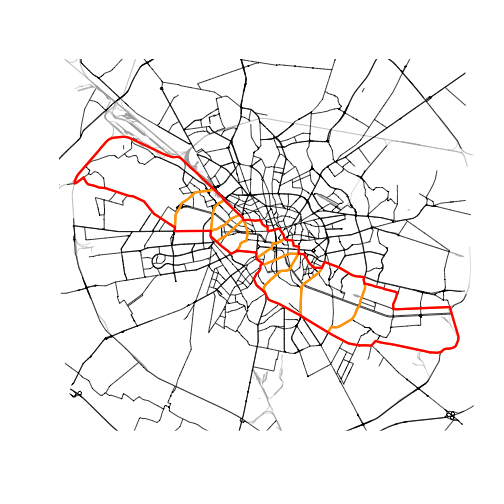What is rcrisp?
rcrisp automates the morphological delineation of
riverside urban areas following a method developed by Forgaci (2018, pp.
88–89). It overcomes the challenge of arbitrary urban river
corridor delineation by providing a reliable workflow to produce
morphologically grounded spatial analytical units.
Such spatial units enable integrated local analyses (many different layers within one case) and large-scale cross-case analyses (many cases using comparable spatial units) in a wide range of domains of application, such as urban planning, environmental management, public space design, and disaster risk reduction.
In short, given a city name and a river name, it:
- identifies corridor boundaries on the street network along the edges of the river valley;
- (optionally) segments the corridor; and
- (optionally) delineates the river space.
Workflow
- Acquire base data:
- OpenStreetMap layers using
get_osm_*()functions - (Optional) global Digital Elevation Model data
- OpenStreetMap layers using
- Delineate the river valley, corridor, segments and/or riverspace
with the all-in-one
delineate()function or with the dedicateddelineate_*()functions - Visualize, validate, and export results for use in downstream analyses
Data considerations
- Use an appropriate projected CRS (e.g., a relevant UTM EPSG code).
- Verify OSM coverage and elevation availability for your area.
- Spatial (street and railway) network completeness and elevation data quality may affect corridor and segment accuracy.
- The
delineate()function retrieves OSM data and global DEM data by default, so no additional data retrieval is needed. - The
delineate_*()functions allow for any data input, not only OSM and global DEM data.
Example
library(rcrisp)
# Parameters
city_name <- "Bucharest"
river_name <- "Dâmbovița"
epsg_code <- 32635
# Delineation
bd <- delineate(city_name, river_name, segments = TRUE)
# Base layers for visualisation
bb <- get_osm_bb(city_name)
streets <- get_osm_streets(bb, epsg_code)$geometry
railways <- get_osm_railways(bb, epsg_code)$geometry
# Plot
plot(bd$corridor)
plot(railways, col = "darkgrey", add = TRUE, lwd = 0.5)
plot(streets, add = TRUE)
plot(bd$segments, border = "orange", add = TRUE, lwd = 3)
plot(bd$corridor, border = "red", add = TRUE, lwd = 3)
Interpretation and next steps
- Use the segments and/or river spaces for comparative analyses along the river; or
- Integrate relevant data layers within a segment and/or river space of interest; or
- Run the analysis on other cities to compare a phenomenon of interest across corridors, segments and/or river spaces;
- Export to GIS formats for further processing.
References
Forgaci, C. (2018). Integrated urban river corridors: Spatial design
for social-ecological integration in bucharest and beyond [PhD
thesis]. https://doi.org/10.7480/abe.2018.31